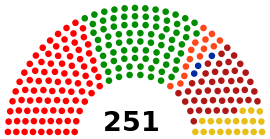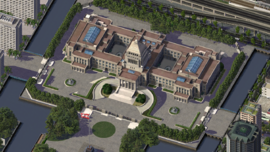House of Officers of Okaiken
| House of Officers 公議院 Kōgiin | |
|---|---|
| The 35th House of Officers | |
 | |
| Type | |
| Type | |
| Leadership | |
President |
Iso Eriko, SCP Since January 29, 2019 |
Majority caucus leader |
Kobayakawa Ryōtarō, SCP Since January 29, 2019 |
Minority Caucus Leader |
Watai Hideharu, LDP Since January 29, 2019 |
| Structure | |
| Seats |
251 |
 | |
Political groups |
(by party as of Aug. 2016) SCP (90)
PPO (80)
OSP (14)
SDP (3)
Opposition (64): LDP (44)
Kōmeitō (20) |
| Elections | |
| Direct Party and Representative Voting System (251 seats) | |
Last election | May 15, 2012 |
Next election | May 15, 2017 |
| Meeting place | |
 | |
|
The House of Officers Building Okami,Okaiken | |
The House of Officers (公議院 Kōgiin) is the upper house of the National Diet of Okaiken. The House of Commoners is the lower house.
The House of Representatives has 251 members, on which half are elected on seven-year terms. All 251 seats are determined by the Direct Party and Representative Voting System, a form of proportional voting.
The House of Officers is the less powerful of the two houses, as it was unable to override vetoes on bills imposed by the House of Commoners. It, however, cannot be dissolved by the Prime Minister at will. The upper house is also used to continue government functions during the election period.
Right to vote and candidature[edit | edit source]
- Sanese nationals aged 18 years and older may vote.
- Sanese nationals aged 22 years and older may run for office in the lower house.
Differences between the Upper and Lower Houses[edit | edit source]
The House of Commoners has several powers not given to the House of Officers. If a bill is passed by the lower house (the House of Commoners) but is voted down by the upper house (the House of Officers), the bill is considered declined and sent back to the committee. However, in the case of treaties, the budget and the selection of the prime minister, the House of Officers can only delay passage, but not block the legislation. As a result, the House of Commoners is considered the more powerful house.
Members of the House of Officers, who are elected to a maximum of four years, sit for a shorter term than members of the House of Officers, who are elected to full seven-year terms. The lower house can also be dissolved by the Prime Minister or the passage of a nonconfidence motion, while the House of Officers cannot be dissolved and takes over the temporary, but limited, position in passing laws during a dissolved parliament. Thus the House of Officers is considered to be more sensitive to public opinion, and is termed the "lower house".
Current composition[edit | edit source]
| "In-house group" | Representatives | |
|---|---|---|
| Sanese Communist Party (Okaiken Kyōsantō) | 90 | |
| Progressive Party (Shinpotō) | 80 | |
| Liberal Democratic Party (Jiyūminshutō) | 44 | |
| Komeito (Kōmeitō) | 20 | |
| Socialist Party (Okaiken Shakaitō) | 14 | |
| Social Democratic Party (Shamintō) | 3 | |
| Total | 251 | |
- ↑ House of Officers: Strength of the In-House Groups in the House of Commoners (Sanese version that additionally contains a list of Representatives sorted by group and by represented region: 会派名及び会派別所属議員数)